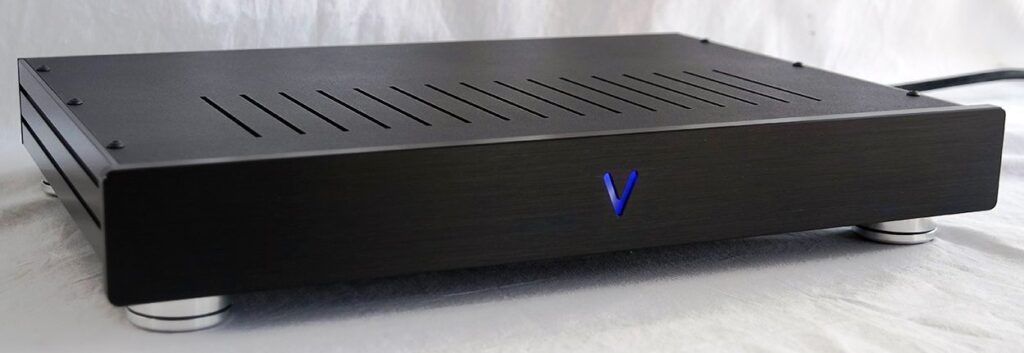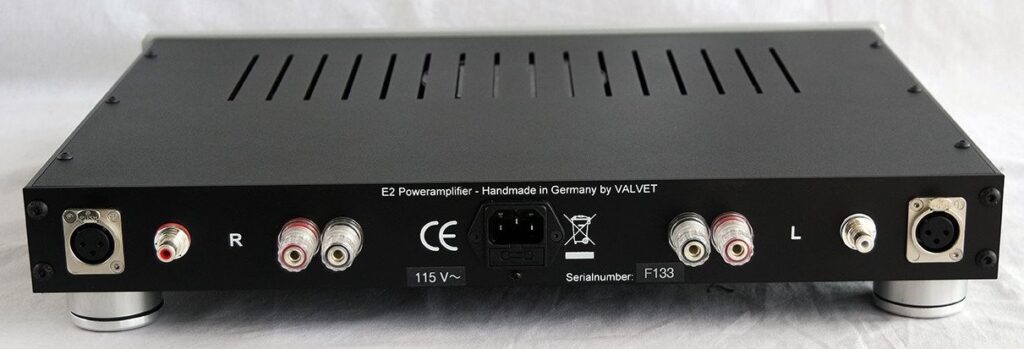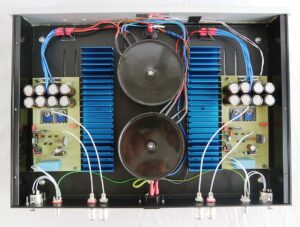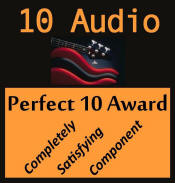Valvet High-End Audio, of Bargteheide, which is near Hamburg in northern Germany, has been making high quality audio components since 1982. Owner and designer Knut Cornils has a goal for all of his components: “(T)he transmission of music free from artefact or manipulation, music that stimulates the senses! A simple but well-thought-out circuit, short signal paths and the best, reliable components”. This sounds like a great goal, so let’s see how successful he is with the E2 power amplifier.
The Valvet E2 is a Class A, single-ended, solid state dual mono power amplifier with a rated power output of 12 Watts per channel into 8 Ohms and 20 WPC into 4 Ohms. There is only one output transistor per channel since Mr. Cornils feels that adding parallel transistors for greater power is detrimental to the sound. The amplifier uses very high-quality parts such as Mundorf silver/gold/oil capacitors, Vishay resistors, and pure silver wiring. The E2 offers both balanced XLR and unbalanced RCA inputs. Being a single-ended amplifier, it treats the XLR inputs as unbalanced RCA, which they parallel. Turning on the amplifier causes an illuminated blue ‘V’ to appear on the otherwise bare front panel, which measures 9mm thick. The power switch is located on the bottom of the amplifier, just under the front panel. The amplifier is small and light weight: 17.5 inches W x 2 inches H x 11.8 inches D, and 17 pounds. It uses about 0.8A, 70 Watts of electric power. The enclosure becomes warm to the touch, the bottom surface uncomfortably so. The E2 has been perfectly reliable during the two month review period.

There are few single-ended solid-state power amplifiers being made today, probably because many audio consumers share the old notion that they need a lot of power (more on this below). A Web search turned up the Valvet E2 which led to contacting Valvet’s very kind and helpful US dealer and importer, Alfred Kainz of highend-electronics, Inc. (link below)
Brand new out of the box, the amplifier sounds formal: stiff with minimal warmth. Obviously, more break in was going to be needed. Mr. Kainz recommends 150-200 hours of break in. The E2 was sounding good, with a strong dose of anticipation for the final sound, at about 100 hours. I ran the E2 for 300 hours before the serious audition began. There was minimal change between 200 and 300 hours of initial use, just a minor further sweetening and smoothness. The audition is off to a good start.
Other components on hand during the review include a VPI Aries 3 turntable with a Kuzma 4-Point tonearm, ZYX UNIverse Premium and Miyajima Madake moving coil cartridges; Pass Labs XP-25, BMC MCCI and MCCI Signature ULN phono preamplifiers; custom Windows 10 music computer running JRiver Media Center; Bryston BDA-3 DA converter; RME ADI-2 Pro AD/DA converter with external power supply; Mark Levinson No. 52, Wyred4Sound STP-SE Stage 2, PS Audio BHK Signature, and Acoustic Imagery Jay-Sho preamplifiers; Cary CAD-805AE, Inspire Fire-Bottle SE, First Watt J2, PS Audio Stellar S300, Nord One Up, Audio Alchemy DPA-1, and Pass Labs XA30.8 power amplifiers; Focal Sopra 1 and Fritzspeakers Carrera BE loudspeakers with the lowest few Hertz supplied by a pair of JL Audio e110 subwoofers, and Focal Chorus 714 loudspeakers borrowed from the HT system. The audio cabling is Audioquest WEL Signature and Mogami interconnects and speaker cables. USB cables are Straight Wire USB-F and Wyred4Sound USB PCOCC Premium. Power cords include my DIY power cord and Straight Wire Pro Thunder. Power protection and purification are provided by a PS Audio Dectet for the preamplifiers and source components, and a PS Audio Quintet for the power amplifiers. The latter provides remote turn-on and -off of power amplifiers that lack a 12V remote trigger, including the E2.
At this point, I encourage you take a moment to see the cornerstone of the reviews here on 10 Audio, found on the Zen Page.
Let’s jump right in. The sound quality of the Valvet E2 is extraordinary. On “Tom’s Diner” by Suzanne Vega (KBCO Studio C, Vol. 20), the feeling of the presence of Ms. Vega right here in my listening room is without peer. The transport of her singing live and in person is as close as I have ever felt from recorded music. And this is a CD!

Listen to Bruce Springsteen’s Tunnel of Love LP. The wood sticks on “Two Faces” and “Brilliant Disguise” sound so real and present, it is startling. The sound has great snap and immediacy. There is no doubt that these are made of wood, one wood stick striking another. The complex harmonic structure of the event, lasting only a fraction of a second, is thoroughly convincing.
Another example of stellar performance is side 1 of Dreamboat Annie, the old 1975 LP by Heart, on Mushroom Records MRS-5005. The album has many special moments with beautiful melodies and vocals from the wonderful Wilson sisters. Although a little trippy in places, this old album is definitely worth a run through the record cleaner and another play on your turntable.
Other performances, from Saint-Saëns, Mozart, Brad Paisley, Dire Straits, Doobie Brothers, The Nylons, Sting, Yello, and many others are equally compelling. This is due to the lack of character of the Valvet E2 amplifier, which means a very complete, unaltered, unfiltered presentation. The perfectly clean window. Dropping of the final veil. Trying to pin a character label on the E2 is difficult. The amplifier seems to have a completely even presentation, absolutely linear from bass to treble with no highlighting or weak area. This includes consistent harmonic depth and texture across all octaves, which is a rare attribute of power amplifiers of any type. Music flows. The two basic requirements for any audio component of ultimate resolution and perfect linearity are delivered in full measure with the Valvet E2. Wonderful!
Solid-state amplifiers tend to have tighter, deeper bass and more linear treble than tube amplifiers. Vacuum tube components are valued for their superior harmonic depth, rich midrange, and beautiful upper frequencies. The Valvet E2 blends the best of these two highly desired characters, which makes trying to determine the underlying technology – tube or solid-state – nearly impossible. This is due to the E2 apparently having the highly valued qualities of vacuum tube amplifiers, while being in good company in the areas where solid-state usually shines. Objectively, in every musically important area, the Valvet amp plays with other top performers. But all this is just the opening act.
There is something very special about single-ended amplifiers. There is no inverted, mirror-image signal that needs to be processed before the amplifier’s speaker terminals. Single-ended amplifiers offer a purity, a naturalness, an accessibility, an ease that push-pull and digital amps rarely deliver at this very high level of performance. With today’s high resolution tweeters, this is audible. The class of amplifier operation, Class A, AB, D, H, etc., or if it is tube or solid-state, is less important than whether the amplifier is or is not single-ended. Class A biasing is usually better sounding than Class AB, but single-ended leaves them both in the dust as far as sonic importance goes. This listener has lately come to regard single-ended amplifiers as the definitive technology for audio power amplifiers after experiences over the past few years with single-ended amplifiers from Cary, Inspire, First Watt and Valvet. (This might turn out to be just a detour on the long and winding road of my audio journey.) Single-ended amplifiers mimic Mother Nature: Nature is totally single-ended. No other amplifier technology, including digital, has yet to match the truthfullness of single-ended, or Nature!
Many amplifiers seem to have an unnatural treble range, possibly due to the ear’s sensitivity to high frequency impurities caused by other amplifier topologies. Their presentation is full of not-air and not-sparkle which sounds nice initially, but gradually becomes tiresome and annoying because it is not-real. The Valvet E2 has all the air and openness and extension and resolution one could wish for, but this presentation is totally without brightness, glare or other upper frequency discord. The ear relaxes and welcomes the sound in. The sense of the actual recording space or venue is outstanding. The feeling of the recording space is very rich and fully saturated, offering tonally and harmonically dense acoustic environments with huge soundstages, when appropriate. Even without 3D glasses, a listener will experience Virtual Reality. The Valvet E2 amplifier offers this musical immersion not only on special cuts or certain parts of a recording, but all the time. Everything simply sounds correct, more like the sounds that originally went into the microphones. It is normal to feel a connection to the performers and be enthralled by their performances. This truthfulness and transparency places a tremendous burden for fine performance on upstream components. This amplifier will deliver the best that a complementary system has to offer. The pairing with Focal Sopra 1 speakers is magical.

Let’s address the elephant in the room: Power. Many of you have been thinking something along these lines: “Only 12 Watts? Are you freakin’ kidding me?” Ok, I get it, but how much power do you really need? This depends on three things: your speakers, your room, and how loudly you choose to listen. Due to the unknown variables, I can’t answer for you. But I can tell you what’s happening in my room which is about 1,800 cubic feet. The Focal Sopra 1 speakers used to measure the Valvet amplifier have sensitivity listed as 90 dB. I listen with the loudest levels at around 100 dB peak SPL (sound pressure level), and 85 dB SPL C-weighted, Slow Response, at the listening seat. Most listening is around 75-80 dBC, 85-90 dB peak. The Mobile Tools app, with SPL add-in, together with a calibrated Dayton iMM-6 microphone plugged into my iPhone, provides an accurate and inexpensive measurement tool. Also get the Mobile Tools FFT Analyzer add-in for a complete measurement solution. Also recommended is the free NIOSH SPL app (National Institute for Occupational Safety and Health) – search NIOSH SPL. The Valvet E2 amplifier manages to deliver those 100 dB peaks and steady 85 dB SPLs with little apparent distortion or overload.
TEST NOTE: Loudness was increased very slowly during these tests, listening very closely for the beginnings of distortion which is a precursor to overload. A little bad power causes more speaker damage than too much good power.
The Class A Pass XA30.8 has a bit more slam in the low bass, while the lower bass of the E2 is satisfyingly potent and tuneful, and superior to the tube amps. The E2 is relatively warmer than the more up-front First Watt J2, but without any loss of information or resolution. On the contrary, a small increase in low level resolution was noted with the Valvet amplifier. Even the highly regarded Cary 805AE, which features a Psvane WE211 power tube with a 300B driver tube, presenting some of the meatiest “tube sound”, met its match with the E2 due to the latter’s linearity near the limits of hearing. The Valvet E2 excels with singers.
To put the overall sound of the E2 in perspective with the other amps on hand, it might be best to state this condition in practical terms. After the 300 hours of break in on the Valvet amp, changing to the other amps – allowing for proper warm up – was a system demotion. We get used to a level of performance and “tune” our brains to accept this situation, the new normal. It was always quickly apparent that removing the Valvet E2 amp and substituting another amp resulted in a reduction in enjoyment and immersion in the music. The sound becomes processed, mechanical. The reality or believability factor is noticeably reduced when the Valvet amplifier is replaced. Listening to music with this amplifier is a sensory experience, compelling and very immersive.
The constant connection to the music and outstanding level of enjoyment that is felt with the Valvet E2 can cause a complete rethink of your system, especially your speakers. After hearing what the E2 can do, it will seem unwise to have inefficient speakers that require gobs of inferior power. This is so obvious. No, you won’t be forced to replace your favorite speakers with huge horns that offer >100 dB efficiency. But speakers with sensitivities in the upper 80 to low-mid 90 dB range could be considered. As more audiophiles understand how great this and other single-ended amplifiers are and demand higher efficiency speakers, speaker manufacturers will focus on developing more sensitive speakers. There are already some good options available today. The old wisdom of first choosing speakers and then buying an amplifier to drive them has a serious flaw. There are many good speakers, but very few amplifiers are on par with this Valvet E2. The sound system for the Orgasmatron will surely use this amplifier!
The Valvet E2 is easily the best sounding amplifier this lifelong audiophile has heard. And it is only $2,990, with no tube issues to drain your bank account in the future. Components like this make us think “I’m done upgrading.” That thought is usually accompanied by a wonderful feeling that we enjoy when a new component seems to be as good as it can get. How long that feeling lasts determines if your initial assessment was correct. So, let me share my two take-aways from reviewing the Valvet E2 Class A single-ended stereo power amplifier. 1) I’m done upgrading, and 2) I bought it. This is a great amplifier!
Overall Rating: 10 LPs

This review would not have been possible without the kind and generous support of Alfred Kainz of highend-electronics, Inc. Thank you, Alfred!
Link to distributor: highend-electronics, Inc.
